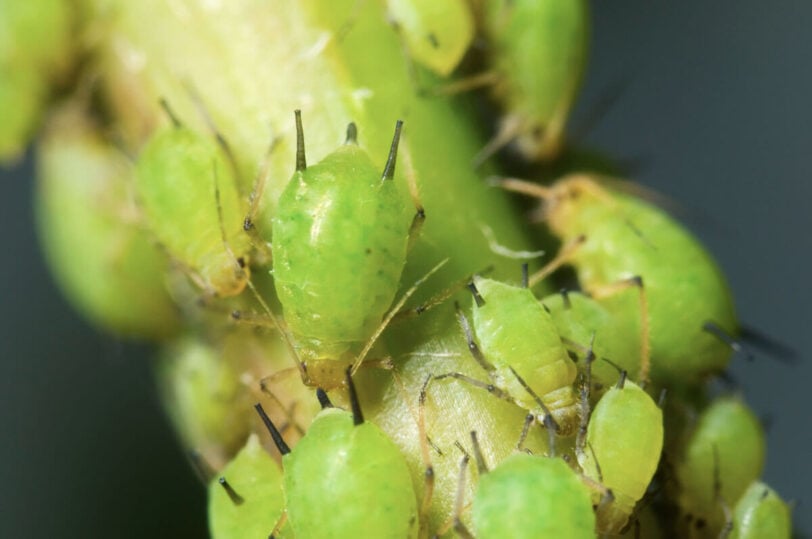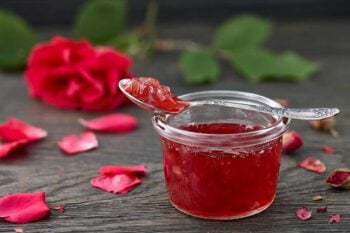Aphids, sometimes called plant lice, are small insects that feed on the nutritious sap of plants. They are a common pest that can cause damage to a wide range of crops, including fruits, vegetables, and ornamental plants.
Aphids produce multiple generations each year and infestations can quickly get out of hand. The good news is that aphids move slowly and have weak legs and soft bodies, making them easier to control.
Here are ten methods to help you control aphids organically, without the use of synthetic pesticides.
What are Aphids?
Aphids are tiny, soft-bodied insects. Most adults are under 1/8-inch, and some may be so small as to look like tiny specks of dirt. There are many species of aphids, and they can appear white, black, brown, gray, yellow, light green, pink, or red. They often blend in with the plants they prefer, making them hard to spot until you have a large infestation.
Aphids have pear-shaped bodies with long antennae, and their larvae and nymphs look similar to the adults. Most species have two short tubes called cornicles projecting from their rear end, and straw-like mouthparts.
Adults are typically wingless, but most species will grow wings when populations get overcrowded in order to travel to other plants, reproduce, and start new colonies.
How Aphids Multiply So Fast
Aphids are the most reproductive insects in the garden. A single female aphid reproduces asexually, giving live birth to 50 to 100 cloned female offspring that are born already pregnant, and there might be 20–40 generations per aphid annually. This means a single aphid alone could create several billion cloned descendants in a single growing season. Multiply this across an entire colony of female aphids, and you can see how an infestation could quickly overwhelm your plants—possibly spreading disease throughout your garden.
Aphids reproduce by asexual live birth during the growing season, but generate male offspring to mate with in the fall, producing eggs that overwinter in the garden and hatch in the spring. However, in warmer climates, these prolific bugs can be a year-round problem.

Signs of Aphid Damage
Aphids can usually be found feeding in large clusters that can sometimes entirely cover a stem, bud or leaf. They feed on soft stems, the tender undersides of leaves, fresh flower buds and new fruit, preferring to suck the plant juices from new growth over established foliage. This curls or yellows the leaves, stunts the plant, deforms your flower buds, and damages your fruit.
Aphids secrete a sticky substance called honeydew that strongly attracts ants. Honeydew is basically aphid poo, and ants love it so much, they are known to protect aphids from predators and even “herd” them into tight colonies so they can harvest honeydew more efficiently. So if you have a lot of ants in your garden, you likely also have an aphid infestation nearby. Preventing and controlling ants can also help control aphids.

Aphids often spread plant viruses and fungal diseases, which can be devastating to crops like cucumbers, citrus, potatoes and grains. Additionally, honeydew from aphids itself can encourage a fungus called sooty mold, causing branches and leaves to appear black.
Related:
- How to Control Fungus Gnats and Damping Off Organically
- How to Control Powdery Mildew Organically
- How to Get Rid of Fruit Flies Naturally
- Organic Garden Disease Control
Organic Control of Aphids
Monitoring, prevention and organic pest control methods like the following are your best bet at controlling aphids in your garden.
1. Consistent Watering
Plants become vulnerable and even stressed during hot, dry conditions, and as a result, they’re not able to produce the chemicals they need to fend off pests. Drought can also concentrate the sugars in plant sap and make it more attractive to aphids.
Summer is prime time for aphid infestations. Be sure to water your plants consistently during hot months, ideally using a drip irrigation system on a timer that waters regularly and deeply at the soil level.
2. Proper Fertilization
Excess nitrogen and over-fertilization causes a flush of new growth that aphids love. Always test your soil and feed your plants an organic, slow-release fertilizer only when needed, and according to test results.
3. Companion Planting
Companion planting is a proven method to help control aphids, either by deterring them away from your plants, or by trapping them on plants they like better.
For example, aphids are typically repelled by catnip, garlic, onions, chives, leeks, rosemary, lavender, peppermint, basil, and marigolds. Plant these near lettuce, peas, tomatoes, roses, and other aphid-prone crops, because their strong scents will deter pests.
However, aphids are especially attracted to zinnias, cosmos, asters, mustard and nasturtiums. Plant these near more valuable plants as trap crops for the aphids, because they will most likely infest these plants before they do others. Check and either treat or remove your trap plants regularly to keep aphid populations from jumping to your more valued plants. Put infested plants into the trash rather than the compost.
Companion planting can be an effective way to prevent and contain aphids, but it may not work fast enough to eliminate an existing infestation, once it has established.
4. Beneficial Insects
One of the most effective ways to prevent and control aphids organically is through the use of beneficial insects. Ladybugs (lady beetles and their larvae), lacewings, and parasitic wasps are all natural predators of aphids, and can be used to control populations. Lacewings, in particular, are voracious aphid-eaters. These insects can be purchased from garden suppliers and nurseries, and released into your garden or greenhouse.
You can also encourage native beneficial insects to take up residence in your yard (or keep the ones you bought and released!) by providing them with lots of the small flowers they prefer as food and habitat such as fennel, dill, yarrow, thyme, sweet alyssum, lantana, mint, etc.,
It is important to note that beneficial insects are most effective when used preventively and in conjunction with other control methods, and may not be sufficient on their own to eliminate an infestation.

5. Physical Removal
Physically removing aphids by spraying them off with a blast of water from the garden hose, or using your fingers or a soft brush to remove and squish them can be very effective for small infestations.
Hosing the aphids off also rinses off some of the aphid honeydew, making the plant less attractive to ants as well. Repeat spraying or wiping every few days as needed until the aphid population is visibly reduced.
You can also prune away branches that are very infested, damaged or sickly. Be sure to put any infested cuttings into the trash, not the compost!
6. Insecticidal Soap
Another organic method of controlling aphids is using insecticidal soap. This is a specially formulated soap made from potassium salts and fatty acids that kills aphids and other soft-bodied insects by dissolving their waxy coating and drying them out.
For mild infestations, you can make your own soap spray by combining a quart of water with a teaspoon of liquid dish soap in a spray bottle.
Insecticidal soap only works when it comes into direct contact with the insects, so it’s best to spray in the morning or late in the evening, when the temperature is cooler and aphids are less active. Applying insecticidal soap (or any plant spray) during the heat of the day can damage the leaves of your plants. Be aware that soap sprays can also taint the flavor of leafy greens.
Where to find insecticidal soap.
7. Neem Oil
Neem oil is a natural oil that is derived from the seeds of the neem tree, which grows in India. It has been used for centuries as an insecticide and is known to be effective against a wide range of soft-bodied pests, including aphids, by suffocating and poisoning them.
Neem oil can be mixed with water and applied directly to the plants, or bought pre-mixed. It is most effective when applied directly to the insects early in the morning or late in the evening when they are less active and the sun is less intense.

8. Horticultural Oil
Horticultural oil is a specially formulated oil made from a variety of oils (including sometimes mineral oil) that is mixed with water and applied to smother pests and suffocate them. Horticultural oil is most effective when used to control aphids on fruit trees, shrubs and woody perennials. It’s not a good choice for aphid control on leafy greens or other tender vegetables.
As with all garden sprays, apply early in the morning or late in the evening when the sun is less intense and the aphids are the least active.
Where to find horticultural oil.
9. Alcohol Spray
Alcohol spray is another organic method of controlling aphids. This is made from mixing equal parts of 70% ethyl alcohol and water in a spray bottle. Ethyl alcohol is known to be effective against a wide range of soft-bodied pests, including aphids, and acts by drying them out.
Alcohol spray should NOT be sprayed over the entire plant at once. Instead, spray or wipe down only infested areas. Alcohol will only kill the aphids it comes into contact with, so repeated applications may be necessary. Alcohol spray is most effective when applied early in the morning or late in the evening when the aphids are less active and the sun is least intense. Leaf damage might occur if sprayed during the heat of the day.
Where to find 70% ethyl alcohol.
10. Diatomaceous Earth
Diatomaceous earth (also called DE) is the pulverized, fossil remains of tiny, aquatic organisms called diatoms. DE naturally accumulates in rivers, lakes, and oceans, where it’s mined. DE is safe for human and animal use, as long as it is not inhaled.
Diatoms have microscopic sharp edges that cut through the waxy outer layer of an insect’s body upon contact, fatally dehydrating it. Any soft-bodied insect that crosses through or is sprinkled with DE dies, including aphids, slugs, snails, ants, caterpillars, fleas, and more, making it very useful for organic pest control.
Inspect all the stems, leaves and buds of your plants (as well as the soil) for aphids and their eggs, and sprinkle or spray them with a fine layer of DE once every few days. Make sure you use food-grade DE and NOT pool-grade DE, which is used for filtration in swimming pools and fish tanks. Pool-grade DE is not safe to use around crops because of its high concentration of silica, a potent lung irritant.
Because the dust is easily washed away, DE needs to be reapplied after rain, high humidity, or overhead irrigation. Avoid using DE on plants that are flowering because DE can also kill pollinators such as bees and butterflies.
Where to find food grade diatomaceous earth.













